重庆医科大学:《传染病学》课程教学资源(教案讲稿)霍乱 Cholera
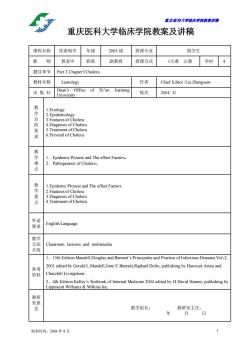
置庆医科大学脑床学院裁来讲满 重庆医科大学临床学院教案及讲稿 课程名称传染病学年级2005级授课专业 留学生 教师曾爱中职称 副教授授课方式 大课示教学时4 题目章节Part3 Chapter3 Cholera 教材名称Lemology f作者Chief Editor:Liu Zhengwen 出版社Dca50 tice of Xi'an1 aon 版次 2004.1 University 教学目的要求 olera 6.Preventl of Cholera 教学难 of Cholera 1.Epidemic Process and The effect Factors eatures of Chol 4.Treatment of Cholera 外记 要求 English Language 教学 方法 Classroom lectures and multimedia 手段 1.15th Edition Mandell.Douglas and Bennett's Principales and Practice of Infectious Diseasea.Vol-2. 2001 edited by Gerald LMandell,Jone E.Bennett,Raphael Dolin,publishing by Harcourt Ansia and Churchill Livingstone pincott Williams 教研 见 教学组长: 教研室主任: 年 月 制表时间:2004年8月 1
重庆医科大学临床学院教案讲稿 制表时间:2004 年 8 月 1 重庆医科大学临床学院教案及讲稿 课程名称 传染病学 年级 2005 级 授课专业 留学生 教 师 曾爱中 职称 副教授 授课方式 √大课 示教 学时 4 题目章节 Part 3 Chapter3 Cholera 教材名称 Lemology 作者 Chief Editor :Liu Zhengwen 出 版 社 Dean’s Office of Xi’an Jiaotong University 版次 2004 .11 教 学 目 的 要 求 1.Etiology 2.Epidemiology 3.Features of Cholera 4.Diagnosis of Cholera 5.Treatment of Cholera 6.Preventl of Cholera 教 学 难 点 1.Epidemic Process and The effect Factors。 2.Pathogenesis of Cholera。 教 学 重 点 1.Epidemic Process and The effect Factors 2.Features of Cholera 3.Diagnosis of Cholera 4.Treatment of Cholera 外语 要求 English Language 教学 方法 手段 Classroom lectures and multimedia 参考 资料 1、15th Edition Mandell,Douglas and Bennett’s Principales and Practice of Infectious Diseasea.Vol-2, 2001 edited by Gerald L.Mandell,Jone E.Bennett,Raphael Dolin, publishing by Harcourt Ansia and Churchill Livingstone. 2、4th Edition Kelley’s Textbook of Internal Medicine 2004 edited by H.David Humes, publishing by Lippincott Williams & Wilkins Inc. 教研 室意 见 教学组长: 教研室主任: 年 月 日
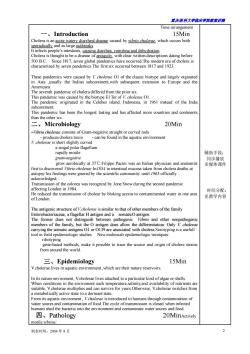
置庆医科大学脑床半院载未讲满 Time arrangement 一、Introduction 15Min Choler nfctPcopleS causin diarrhea vomiting and dehydration ns dating before 500 BC Since 1817 se en global p mics have occu red The of cholera is characterized by seven pandemics.The first six occurred between 1817 and 1923. he andemi ype EI Tor of cholerae Ol. The pandemic originated in the Celebes island,Indonesia,in 1961 instead of the India has been the longest lasting and has affected more and continen han the other six 二、Microbiology 20Min tly curved can be found in the aquatic environmen a singal pola rapidly motile 辅助手段: Cip Pc ai first to discovered mucosa taker his findings were gnored by the scientific community Transmission of the cole rea was recognizd by Jone Snow during the second pandemic n London in 时间分配: sion of cholear by bloking access to contaminented water in one are of London 见教学内容 en The former does not distinguish between pathogenic tamily,but es allow the 0130 efull olmdcpdemiologcudes"NemcueargpidcmoigecRempepagsar 三、Epidemiology 15Min V.cholerae lives in aquatic environment,which are their nature reservoirs atached kind of nts a ly active state to a mant stat ns shed the bacteria into the environment and contaminate water soures ar 四、Pathology 20MinActively motile vibrios: 制表时间:2004年8月
重庆医科大学临床学院教案讲稿 制表时间:2004 年 8 月 2 Time arrangement 一、Introduction 15Min Cholera is an acute watery diarrheal disease caused by vibrio cholerae, which occurs both sporadically and as large outbreaks. It infects people’s intestines, causing diarrhea, vomiting and dehydration. Cholera is thought to be a disease of antiquity, with clear written descriptions dating before 500 B.C. Since 1817, seven global pandemics have occurred.The modern era of cholera is characterized by seven pandemics.The first six occurred between 1817 and 1923. These pandemics were caused by V. cholerae O1 of the classic biotype and largely orginated in Asia ,usually the Indian subcontinent,with subsequent extension to Europe and the Americans. The seventh pandemic of cholera differed from the prior six. This pandemic was caused by the biotype El Tor of V. cholerae O1. The pandemic originated in the Celebes island, Indonesia, in 1961 instead of the India subcontinent. This pandemic has been the longest lasting and has affected more countries and continents than the other six. 二、Microbiology 20Min -Vibrio cholerae consists of Gram-negative straight or curved rods - produces cholera toxin - can be found in the aquatic environment V. cholerae is short slightly curved a singal polar flagellum rapidly motile gram-negative grow aerobically at 37℃.Filippo Pacini was an Italian physician and anatomist first to discovered Vibrio cholerae In1854 in intestinal mucosa taken from cholera deaths at autopsy his findings were gnored by the scientific community until 1965 officially acknowledged. Transmission of the colorea was recognizd by Jone Snow during the second pandemic affecting London in 1984. He reduced the transmission of cholear by bloking access to contaminented water in one area of London. The antigenic structure of V.cholerae is similar to that of other members of the family Enterobacteriaceae, a flagellar H antigen and a somaticO antigen. The former does not distinguish between pathogenic Vibrio and other nonpathogenic members of the family, but the O antigen does allow the differentiation. Only V. cholerae carrying the somatic antigens O1 or O139 are associated with cholera.Serotyping is a usefull tool in field epidemiologic studies. New molecualr epidemiologic tecniques: ribotyping gene-based methods, make it possible to trace the source and origin of cholera strains from around the world. 三、Epidemiology 15Min V.cholerae lives in aquatic environment ,which are their nature reservoirs. In its nature enviroment, V.cholerae lives attached to a particular kind of algae or shells. When conditions in the enviroment such temperature,salinity,and availability of nutrients are suitable, V.cholerae multiplies and can survive for years.Otherwise, V.cholerae switches from a metabolically active state to a dormant state. From its aquatic enviroment , V.cholerae is introduced to humans through contamination of water soures and contamination of food.The cycle of transmission is closed when infected humans shed the bacteria into the environment and contaminate water soures and food. 四、Pathology 20MinActively motile vibrios: 辅助手段: 同步播放 多媒体课件 时间分配: 见教学内容

露庆医科大学临床半院载案讲满 inical disease by intestine. hen of s has five B subunits and two A subunits CTX a protein of 8.000 daltons(MW) one subunit(Al and A2) The d) nonfecal onammaoee no cellular da Since V.cholerae does not invade the intestinal cell,no toxin absorbed.In short all sign bonate 五、clinical manifestations 20Min The hallmark of cholera is the production of watery with varying degree of dehydration production of watery diarrhea withou trtQsmsorponHiRemtldomimalpamepidyfoibedbyomiting dehydration and shock can kill a person within hours.Fever is observed in less than5% Patients look anxious and restless,the eyes are very sunken,mucous membernes are dry the city and when pinched retracts very slowly,the voice is almost ck and de prom r hefore diarthea ars the voluminous secretion poonntendoof bowel and otitherdiareaorom mptoms and signs:sudden onset of watery diarrhea up to 1 liter per hour diarrhea has a appearance diarrhea has a"fishy"odor dehydration cn occur rapidly rapid pulse (heart rate)dry mucus membranes or dry mouth Note:Symptoms can vary from mild t 六、Lab findings 20Min Stool:may or may not have WBC or RBC Blood plasma proteins t Erythrocyte Sedimentation Rate(ESR) artcrial pH bicarbonate potassium sodium chloride Under phaseor dark-field applied to wet preparations,movement stoped. thiosulfate citrate-bilesalt-sucrose(TCBS)agar,which is very stable and selective for vibrios 制表时间:2004年8月
重庆医科大学临床学院教案讲稿 制表时间:2004 年 8 月 3 penetrating mucous layers attaching to the brush border of the intestinal epithelium, secreting a potent cholera toxin CTXV.cholerae O1 and O139 cause clinical disease by secreting an enterotoxin that promotes secretion of fluids and electrolytes by the small intestine. The toxin was has five B subunits and two A subunits.CTX a protein of 84,000 daltons(MW) consisting of: one A subunit(A1 and A2) five B subunits(B pentamer) The fluid lost in cholera is: nonfecal slightly fishy-smelling, whitish mucous-flecked liquid no cellular damage no inflammation Since V. cholerae does not invade the intestinal cell, no toxin absorbed. In short, all signs and symptoms of cholera derive from the fluid losses which composition is similar to that of plasma enriching in potassium, sodium and bicarbonate. 五、clinical manifestations 20Min The hallmark of cholera is the production of watery with varying degree of dehydration ranging from none to sever and life-threatening diarrhea. Oneset of the disease is abrupt and characterized by the production of watery diarrhea without strain,tensmus,or prominent abdominal pain,rapidly followed by vomiting. Cholera(severe cases) can reduce a perfectly healthy, robust adult to shock and death in 4 to 6 hours.The diarrhea and vomiting brought on by the infection quickly leaves the body without enough fluid. The dehydration and shock can kill a person within hours. Fever is observed in less than 5% of cases. Patients look anxious and restless,the eyes are very sunken,mucous membernes are dry,the skin has lost its elasticity and when pinched retracts very slowly,the voice is almost nonaudible,the intestinal sounds are prominent. Cholera sicca(rare): shock and death occur before diarrhea appears, the voluminous secretions pooling in distended loops of bowel and not escaping as either diarrhea or vomiting. Symptoms and signs::sudden onset of watery diarrhea, up to 1 liter per hour diarrhea has a "rice water" appearance diarrhea has a "fishy" odor dehydration can occur rapidly rapid pulse (heart rate) dry mucus membranes or dry mouth Note: Symptoms can vary from mild to severe. 六、Lab findings 20Min Stool: may or may not have WBC or RBC Blood: plasma proteins ↑ Erythrocyte Sedimentation Rate(ESR) ↑ arterial pH ↓ bicarbonate ↓ potassium ↓ sodium ↓ chloride ↓ Under phase or dark-field microscope: fresh wet preparations the characteristic darting motility of vibrios can be seen Immobilizing Test To be certain that these motile bacteria are V. cholerae, serogroup O1 antisera can be applied to wet preparations, movement stoped. Stool culture: A simple method uses thiosulfate citrate-bilesalt-sucrose (TCBS) agar, which is very stable and selective for vibrios
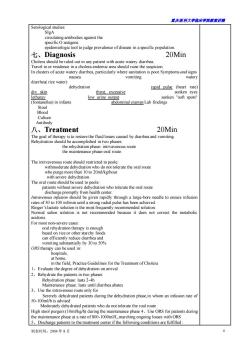
重庆医科大半床半院载未讲满 Serological studies ating antibodies against the epidemiologic tool to judge prevalence of disease in a specific population. 七、Diagnosis 20Min uled out in an Travel toor residence n holeraendemicre houd the uspicion In clusters of acute watery diarrhea,particularly where sin is poor.Symptoms and signs nausea water diarrhea(rice water) dehydration rapid pulse (heart rate Iry skin excessive etharoy low urine output (fontanelles)in infants abdominal cramps Lab findings Culture Antibody 八、Treatment 20Min oal oft the fluid aused by diarrhea and vomiting. who purge more than 10 to lerate the oral route with Ringer'slactate solution is the most frequently ecommended solution. for most non-severe cases Pcin for the Treatmen of Cholera .Evaluate the deg 2、Rehydrate the p Rehydration phase:lasts 2-4h icdeon 50-100m/ ts during the dehydration phase.in whom an infusion rate o Moderately deh phas ORS for tientsduring 5Discharge patients to the treatment center if the following conditions are fulfled 制表时间:2004年8月
重庆医科大学临床学院教案讲稿 制表时间:2004 年 8 月 4 Serological studies: SIgA circulating antibodies against the specific O antigens. epidemiologic tool to judge prevalence of disease in a specific population. 七、Diagnosis 20Min Cholera should be ruled out in any patient with acute watery diarrhea. Travel to or residence in a cholera-endemic area should raise the suspicion. In clusters of acute watery diarrhea, particularly where sanitation is poor.Symptoms and signs nausea vomiting watery diarrhea( rice water) dehydration rapid pulse (heart rate) dry skin thirst, excessive sunken eyes lethargy low urine output sunken "soft spots" (fontanelles) in infants abdominal cramps Lab findings Stool Blood Culture Antibody 八、Treatment 20Min The goal of therapy is to restore the fluid losses caused by diarrhea and vomiting. Rehydration should be accomplished in two phases: the rehydration phase- intrvavenous route the maintenance phase-oral route. The intrvavenous route should restricted to peole: withmoderate dehydration who do not tolerate the oral route who purge more than 10 to 20ml/kg/hour with severe dehydration. The oral route should be used to peole: patients without severe dehydration who tolerate the oral route discharge promptly from health center. Intravenous infusion should be given rapidly through a large-bore needle to ensure infusion rates of 50 to 100 ml/min until a strong radial pulse has been achieved. Ringer’s lactate solution is the most frequently recommended solution. Normal saline solution is not recommended because it does not correct the metabolic acidosis. For most non-severe cases: oral rehydration therapy is enough based on rice or other starchy foods can efficiently reduce diarrhea and vomiting substantially by 30 to 50% ORS therapy can be used in: hospitals, at home, in the field, Practice Guidelines for the Treatment of Cholera 1、Evaluate the degree of dehydration on arrival 2、Rehydrate the patients in two phases: Rehydration phase: lasts 2-4h Maintenance phase: lasts until diarrhea abates 3、Use the intravenous route only for Sererely dehydrated patients during the dehydration phase,in whom an infusion rate of 50-100ml/h is advised Moderately dehydrated patients who do not tolerate the roal route High stool purgers (10ml/kg/h) during the maintenance phase 4、Use ORS for patients during the maintenance phase at a rate of 800-1000ml/L,marching ongoing losses with ORS 5、Discharge patients to the treatment center if the following conditions are fulfilled :
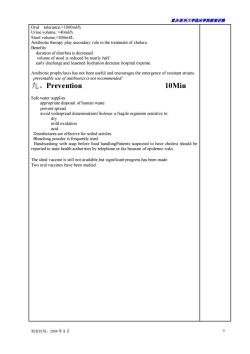
置庆医科大学临床半院麦素讲满 Oral tolerance,>1000ml/h Urine v 400 role in the of Benefits: nearly half early discharge and lessened hydration ecrease hospital expense 九、Prevention 10Min isposal of human waste mintio ole mild oxidation acid ledarticles The ideal vaccine is still not available,but significant progress has been made. Two oral vaccines have been studied. 制表时间:2004年8月
重庆医科大学临床学院教案讲稿 制表时间:2004 年 8 月 5 Oral tolerance,>1000ml/h Urine volume, >40ml/h Stool volume,<400ml/L Antibiotic therapy play secondary role in the treatment of cholera Benefits: duration of diarrhea is decreased volume of stool is reduced by nearly half early discharge and lessened hydration decrease hospital expense. Antibiotic prophylaxis has not been useful and encourages the emergence of resistant strains. preventable use of antibiotics is not recommended! 九、Prevention 10Min Safe water supplies appropriate disposal of human waste prevent spread avoid widespread disseminationCholerae a fragile organism sensitive to: dry mild oxidation acid Disinfectants are effective for soiled articles. Bleaching powder is frequently used. Handwashing with soap before food handlingPatients suspected to have cholera should be reported to state health authorities by telephone or fax because of epidemic risks. The ideal vaccine is still not available,but significant progress has been made. Two oral vaccines have been studied
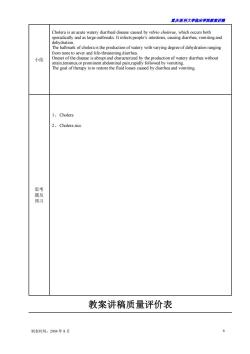
重庆医科大半脑床半院载未讲满 e iting and production of watery with of 小结 bythe production diarhea without es caused l、Cholera 2、Cholera sice 脑 教案讲稿质量评价表 制表时间:2004年8月
重庆医科大学临床学院教案讲稿 制表时间:2004 年 8 月 6 小结 Cholera is an acute watery diarrheal disease caused by vibrio cholerae, which occurs both sporadically and as large outbreaks. It infects people’s intestines, causing diarrhea, vomiting and dehydration. The hallmark of cholera is the production of watery with varying degree of dehydration ranging from none to sever and life-threatening diarrhea. Oneset of the disease is abrupt and characterized by the production of watery diarrhea without strain,tensmus,or prominent abdominal pain,rapidly followed by vomiting. The goal of therapy is to restore the fluid losses caused by diarrhea and vomiting. 思考 题及 预习 1、 Cholera 2、 Cholera sicc 教案讲稿质量评价表
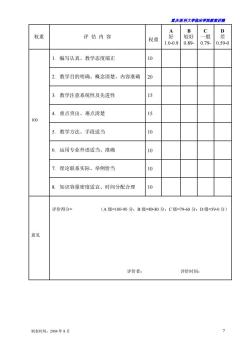
露庆医科大学脑床半院载来讲满 c D 权重 评估内容 一船 权重 较 1.0-0.90.89. 0.79- 0.59-0 编写认真、教学态度端正 10 2. 教学目的明确、概念清楚、内容准确 20 3. 教学注意系统性及先进性 15 4.重点突出、难点清楚 15 100 5. 教学方法、手段适当 10 6 运用专业外语适当、准确 10 7.理论联系实际、举例恰当 0 8.知识容量密度适宜、时间分配合理 10 评价得分= (A级=100-90分:B级=89-80分:C级=79-60分:D级=59-0分) 意见 评价者: 评价时间: 制表时间:2004年8月
重庆医科大学临床学院教案讲稿 制表时间:2004 年 8 月 7 权重 评 估 内 容 权重 A 好 1.0-0.9 B 较好 0.89- C 一般 0.79- D 差 0.59-0 100 1. 编写认真、教学态度端正 10 2. 教学目的明确、概念清楚、内容准确 20 3. 教学注意系统性及先进性 15 4. 重点突出、难点清楚 15 5. 教学方法、手段适当 10 6. 运用专业外语适当、准确 10 7. 理论联系实际、举例恰当 10 8. 知识容量密度适宜、时间分配合理 10 意见 评价得分= (A 级=100-90 分;B 级=89-80 分;C 级=79-60 分;D 级=59-0 分) 评价者: 评价时间:
按次数下载不扣除下载券;
注册用户24小时内重复下载只扣除一次;
顺序:VIP每日次数-->可用次数-->下载券;
- 重庆医科大学:《传染病学》课程教学资源(教案讲稿)肝炎(英文).doc
- 重庆医科大学:《传染病学》课程教学资源(教案讲稿)总论(英文).doc
- 重庆医科大学:《传染病学》课程教学资源(教案讲稿)艾滋病.doc
- 重庆医科大学:《传染病学》课程教学资源(教案讲稿)禽流感.doc
- 重庆医科大学:《传染病学》课程教学资源(教案讲稿)严重急性呼吸综合征.doc
- 重庆医科大学:《传染病学》课程教学资源(教案讲稿)败血症.doc
- 重庆医科大学:《传染病学》课程教学资源(教案讲稿)流行性出血热.doc
- 重庆医科大学:《传染病学》课程教学资源(教案讲稿)霍乱.doc
- 重庆医科大学:《传染病学》课程教学资源(教案讲稿)伤寒.doc
- 重庆医科大学:《传染病学》课程教学资源(教案讲稿)病毒性肝炎.doc
- 重庆医科大学:《传染病学》课程教学资源(教案讲稿)流脑.doc
- 重庆医科大学:《传染病学》课程教学资源(教案讲稿)总论.doc
- 《运动解剖学》课程教学资源(授课教案)运动解剖学完整讲义.docx
- 《运动解剖学》课程基本功大赛复习题及答案(共300题).docx
- 重庆医科大学:《精神病学》课程教学大纲.docx
- 重庆医科大学:《精神病学》课程教学资源(讲稿)精神科急诊与护理.pdf
- 重庆医科大学:《精神病学》课程教学资源(讲稿)精神障碍的护理与康复.pdf
- 重庆医科大学:《精神病学》课程教学资源(讲稿)精神病学总论和症状学.pdf
- 重庆医科大学:《精神病学》课程教学资源(讲稿)精神病学总论及相关法律问题.pdf
- 重庆医科大学:《精神病学》课程教学资源(讲稿)精神活性物质所致精神障碍.pdf
- 重庆医科大学:《传染病学》课程教学资源(教案讲稿)艾滋病(AIDS).doc
- 重庆医科大学:《传染病学》课程教学资源(教案讲稿)细菌性痢疾 Bacillary dysentery.doc
- 重庆医科大学:《传染病学》课程教学资源(教案讲稿)流脑(英文).doc
- 重庆医科大学:《传染病学》课程教学资源(教案讲稿)疟疾(英文).doc
- 《传染病学》课程教学资源(实验指导)病毒性肝炎.doc
- 《传染病学》课程教学资源(实验指导)发热待查.doc
- 《传染病学》课程教学资源(实验指导)腹泻.doc
- 《传染病学》课程教学资源(实验指导)消毒与隔离.doc
- 《传染病学》课程教学资源(作业习题)总论(含参考答案).doc
- 《传染病学》课程教学资源(作业习题)传染性非典型肺炎(含参考答案).doc
- 《传染病学》课程教学资源(作业习题)病毒性肝炎(含参考答案).doc
- 《传染病学》课程教学资源(作业习题)败血症(含参考答案).doc
- 《传染病学》课程教学资源(作业习题)伤寒、副伤寒(含参考答案).doc
- 《传染病学》课程教学资源(作业习题)流行性乙型脑炎(含参考答案).doc
- 《传染病学》课程教学资源(作业习题)霍乱(含参考答案).doc
- 《传染病学》课程教学资源(作业习题)课后习题(含参考答案).doc
- 《传染病学》课程教学资源(作业习题)艾滋病(含参考答案).doc
- 《传染病学》课程教学资源(PPT课件)严重急性呼吸综合征(severe acute respiratory syndrome, SARS).ppt
- 《传染病学》课程教学资源(PPT课件)人禽流感 human avian influenza(重庆医科大学:邓蕙).ppt
- 《传染病学》课程教学资源(PPT课件)流行性出血热.ppt
